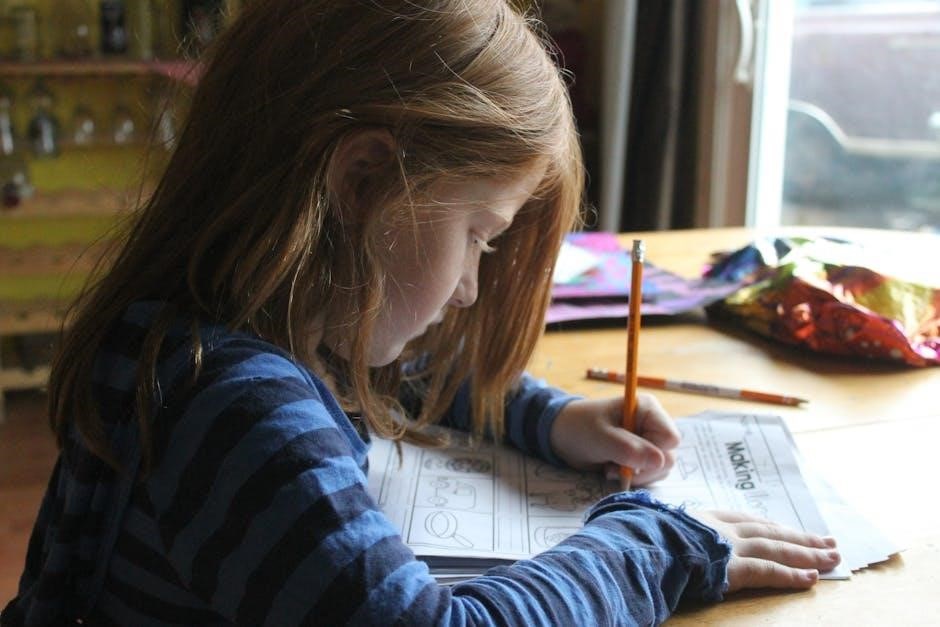probability of compound events worksheet with answers pdf
Compound events involve multiple occurrences happening together or in sequence. They are fundamental in probability, helping calculate combined outcomes in scenarios like dice rolls, coin flips, or card draws.
1.1 Definition of Compound Events
Compound events refer to situations involving two or more individual events occurring together or in sequence. These events can be independent (outcomes of one don’t affect the other) or dependent (outcomes are influenced by preceding events). Examples include rolling dice, flipping coins, or drawing marbles without replacement. Understanding compound events is essential for calculating probabilities in real-world scenarios like weather forecasts or sports outcomes.
1.2 Importance of Understanding Compound Events in Probability
Mastering compound events is crucial for solving complex probability problems. They help predict outcomes in real-life situations, such as weather patterns or financial markets. Understanding these events enhances analytical skills, enabling better decision-making. Worksheets with answers provide practical exercises to grasp key concepts, ensuring a solid foundation in probability theory and its applications.

Types of Probability Rules for Compound Events
Compound events rely on specific probability rules, such as the multiplication rule for independent events and the addition rule for mutually exclusive events, to calculate outcomes accurately.
2.1 Multiplication Rule for Independent Events
The multiplication rule states that if two events are independent, the probability of both occurring is the product of their individual probabilities. For example, the probability of flipping heads and then tails is calculated by multiplying P(heads) by P(tails). This rule applies when the outcome of one event does not affect the other, ensuring accurate combined probability calculations for independent scenarios.
2.2 Addition Rule for Mutually Exclusive Events
Mutually exclusive events cannot occur simultaneously. The addition rule states that the probability of either event occurring is the sum of their individual probabilities. For example, the probability of rolling a 1 or 2 on a die is P(1) + P(2) = 1/6 + 1/6 = 1/3. This rule simplifies calculations for events that cannot overlap, ensuring accurate probability determination for exclusive scenarios.

Independent vs. Dependent Events
Independent events have no effect on each other’s outcomes, while dependent events influence one another. Understanding this distinction is crucial for accurate probability calculations.
3.1 Identifying Independent Events
Independent events occur when the outcome of one event does not affect the probability of another. For example, flipping a coin and rolling a die are independent, as each outcome remains unaffected by the other. To identify independence, check if the probability of one event remains unchanged regardless of the occurrence of another event.
3.2 Identifying Dependent Events
Dependent events occur when the outcome of one event influences the probability of another. For example, drawing a red marble without replacement affects the probability of drawing another red marble. To identify dependence, look for situations where one event alters the conditions or likelihood of the next event occurring. This relationship is crucial for accurate probability calculations in compound scenarios.
Calculating the Probability of Compound Events
Calculating compound probabilities involves understanding event relationships. Use the multiplication rule for independent events and the addition rule for mutually exclusive events to find combined probabilities accurately.
4.1 Step-by-Step Method for Calculations
To calculate compound probabilities, first identify if events are independent or dependent. For independent events, multiply individual probabilities. For dependent events, adjust probabilities based on prior outcomes. Use the addition rule for mutually exclusive events. Always simplify fractions and verify calculations for accuracy. Example: Rolling a 3 on a die (1/6) and drawing a red marble (2/5) results in a compound probability of 2/30 or 1/15.
4.2 Examples of Compound Probability Calculations
Examples include flipping a coin twice, rolling two dice, or drawing marbles without replacement. For instance, the probability of getting heads then tails is 1/2 * 1/2 = 1/4. Drawing a red marble first and then a green marble from a bag with 4 red, 3 green, and 2 yellow marbles is (4/9) * (3/8) = 12/72 = 1/6.

Compound Events Worksheet with Answers
A compound events worksheet provides sample problems and solutions, helping students practice concepts like independent and dependent events, using tools like the multiplication and addition rules.
5.1 Sample Problems for Practice
Sample problems include scenarios like rolling dice, flipping coins, or drawing marbles. For example, calculating the probability of rolling a 6 on two dice or drawing specific colored marbles without replacement. These exercises help students apply rules like multiplication and addition to real-world situations, ensuring a solid grasp of compound probability concepts through practical application.
5.2 Solutions and Explanations
Solutions provide step-by-step answers to sample problems, applying rules like multiplication and addition. Explanations clarify whether events are independent or dependent, ensuring understanding. Answers are presented in simplest fractions or decimals, with detailed reasoning to help students grasp concepts and avoid common mistakes in compound probability calculations.

Real-World Applications of Compound Probability
Compound probability applies to real-life scenarios like weather forecasting, financial decisions, and medical diagnostics, helping predict outcomes when multiple events influence results.
6.1 Examples in Everyday Life
Compound probability is evident in everyday activities like weather forecasting, where predicting rain on consecutive days involves combined probabilities. Financial decisions, such as investment risks, rely on compound probability to assess outcomes. Medical diagnostics use it to determine disease likelihood based on multiple symptoms. These real-world applications highlight how understanding compound events helps make informed decisions in complex scenarios.
6.2 Practical Implications of Understanding Compound Events
Mastering compound events enhances decision-making in finance, engineering, and healthcare. It aids in risk assessment, optimizing strategies, and predicting multi-step outcomes. By accurately calculating combined probabilities, professionals can allocate resources effectively and minimize uncertainties. This knowledge is crucial for designing reliable systems and forecasting future trends, ensuring informed choices in various fields that rely on probabilistic analysis.

Common Misconceptions About Compound Events
A common misconception is confusing independent and dependent events. Many assume all events are independent, leading to incorrect probability calculations. Understanding event relationships is crucial for accuracy.
7.1 Misunderstandings About Independent and Dependent Events
A common misunderstanding is assuming all events are independent. However, dependent events, like drawing marbles without replacement, affect each other. Failing to recognize this relationship leads to incorrect probability calculations. For instance, rolling a die and flipping a coin are independent, but drawing cards without replacement creates dependency. Clarifying event types is essential for accurate probability determination and avoiding errors in compound event analysis.
7.2 Mistakes in Applying Probability Rules
A common error is misapplying the multiplication rule for independent events. For example, calculating the probability of two coin flips as 1/2 * 1/2 = 1/4 for heads both times is correct, but failing to adjust for dependency, like in card draws without replacement, leads to mistakes. Additionally, mistakenly using the addition rule for non-mutually exclusive events can result in overcounting probabilities. Such errors highlight the need for careful event classification and rule application to ensure accurate compound probability calculations and avoid incorrect conclusions in problem-solving scenarios.
Tips for Solving Compound Probability Problems
Use Venn diagrams or tree diagrams to visualize events. Always identify if events are independent or dependent. Double-check calculations and assumptions to avoid errors.
8.1 Strategies for Accurate Calculations
Break down problems into smaller steps, identifying each event’s probability. Use formulas like multiplication and addition rules based on event type. Verify independence or dependence to apply the correct rule. Regular practice with worksheets enhances understanding and reduces errors. Cross-check answers with online tools for accuracy. Detailed step-by-step solutions aid in mastering concepts efficiently.
8;2 Avoiding Common Errors
Common mistakes include misclassifying events as independent or dependent. Always check if one event affects another. Ensure correct application of multiplication and addition rules. Be cautious with probabilities exceeding 1 or being negative. Regular review of solutions helps identify and correct these errors, improving overall problem-solving accuracy and understanding of probability principles effectively.

Resources for Further Learning
Recommended worksheets and online tools like Khan Academy, GeoGebra, and Kuta Software offer interactive exercises and detailed solutions to master compound probability concepts effectively.
9.1 Recommended Worksheets and Exercises
Find comprehensive worksheets with answers on compound probability from platforms like Kuta Software, Khan Academy, and GeoGebra. These resources include exercises on independent and dependent events, offering step-by-step solutions. They cover topics like calculating probabilities for multiple events, identifying event types, and applying rules such as multiplication and addition. Many are available as downloadable PDFs, making them convenient for practice and review.

9.2 Online Tools for Practicing Compound Probability
Enhance your understanding with interactive tools like Kuta Software, Khan Academy, and GeoGebra. These platforms offer exercises, simulations, and quizzes to practice compound probability concepts. Tools like Desmos and Probability Simulators provide visual representations of events, enabling hands-on learning. Many resources include step-by-step solutions and real-time feedback, making them ideal for self-paced study and mastery of compound probability principles.
Mastering compound probability enhances problem-solving skills and real-world decision-making. Regular practice with worksheets and online tools ensures a solid understanding of these essential probability concepts.
10.1 Summary of Key Concepts
Compound events combine multiple outcomes, calculated using multiplication or addition rules. Independent events rely on individual probabilities, while dependent events require adjusting for prior outcomes. Understanding these concepts enhances problem-solving in probability. Regular practice with worksheets and real-world applications solidifies grasp of compound probability, essential for accurate calculations and informed decision-making.
10.2 Final Thoughts on Mastering Compound Events
Mastering compound events requires a strong grasp of probability rules and their applications. Regular practice with diverse problems enhances understanding and problem-solving skills. Emphasize identifying event relationships—独立 or dependent—and apply appropriate rules. Utilize worksheets and real-world examples to reinforce concepts. Diligence and attention to detail ensure accurate calculations and a deeper appreciation for probability in everyday situations and decision-making processes.